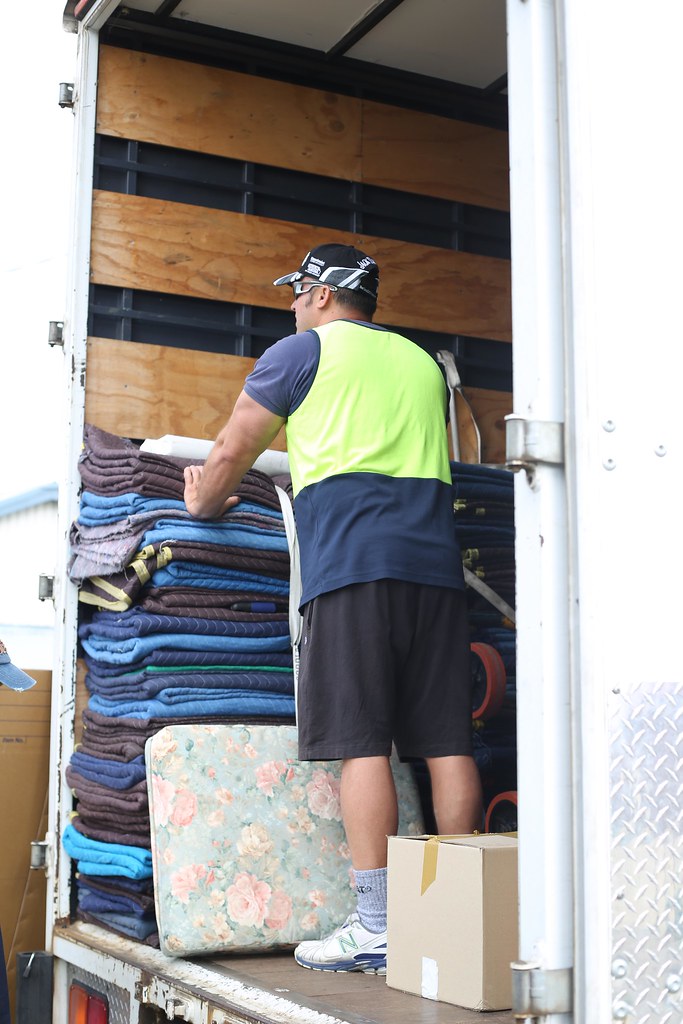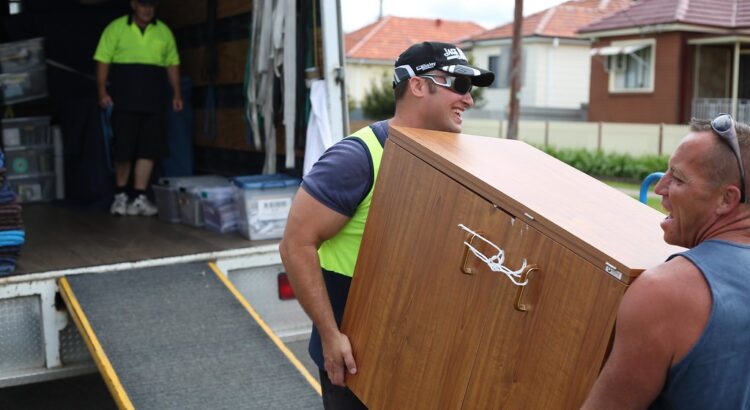- Best Tips When Dealing With A Mover For Furniture
- Understanding the importance of hiring a professional mover for furniture
- Researching and comparing different moving companies
- Communicating your needs and expectations with the mover
- Creating a detailed inventory list of furniture items
- Packing and preparing furniture for the move
- Dealing with unexpected challenges during the move
- Tips for unpacking and setting up furniture in your new home
- The importance of proper insurance coverage when dealing with a mover
- Importance of Choosing the Right Mover for Furniture
- Researching and Comparing Moving Companies
- Preparing Furniture for the Move
- Communicating with the Movers
- Ensuring Safe Transportation of Furniture
- Unpacking and Setting Up Furniture at New Location
- Dealing with Damages or Issues During the Move
- Tips for a Smooth Moving Experience
- Final Thoughts and Recommendations
- Other Related Topics
Best Tips When Dealing With A Mover For Furniture

Moving can be a stressful and overwhelming experience, especially when it comes to moving furniture. Whether you’re relocating to a new home or simply rearranging your living space, hiring a professional mover for your furniture is essential. But with so many options available, how do you choose the right one? In this blog post, we’ll explore the best tips when dealing with a mover for furniture. From researching and comparing moving companies to packing and preparing your precious belongings, we’ve got you covered! So grab a cup of coffee and get ready to make your next move smooth and hassle-free!
Understanding the importance of hiring a professional mover for furniture
When it comes to moving furniture, many people may underestimate the importance of hiring a professional mover. However, there are several compelling reasons why you should consider enlisting the help of experts in this field.
Professional movers have the necessary experience and expertise to handle all types of furniture. They know how to disassemble large pieces, navigate narrow hallways or doorways, and safely transport fragile items without causing damage. This level of skill can save you from potential headaches and costly repairs down the road.
Furthermore, hiring professionals ensures that your furniture is adequately protected during transit. Movers come equipped with specialized tools such as dollies, straps, and padding materials to securely pack and load your belongings onto their trucks. With their knowledge of proper lifting techniques and secure packaging methods, they minimize the risk of accidents or breakages.
Another key advantage is time-saving. Moving furniture on your own can be an arduous task that consumes valuable hours or even days. By entrusting this responsibility to professionals who specialize in efficient packing and transportation processes, you free up precious time for other important tasks associated with moving.
Lastly but certainly not least importantly – peace of mind! Knowing that trained professionals are handling your beloved furniture provides a sense of security throughout the entire process. You can relax knowing that every precaution has been taken to ensure its safe arrival at your new location.
In conclusion (Oops! No concluding here), hiring a professional mover for your furniture offers numerous benefits including expertise in handling various types of items successfully; ensuring proper protection during transit; saving valuable time; and providing peace of mind throughout the move (but no summary!). So when it’s time to make a move with your precious belongings… leave it to the pros!
Researching and comparing different moving companies
When it comes to finding the right mover for your furniture, researching and comparing different moving companies is a crucial step. This process allows you to gather information about each company’s reputation, services offered, pricing, and customer reviews. By taking the time to research and compare multiple options, you can make an informed decision that best suits your needs.
Start by conducting online research on various moving companies in your area. Look for ones with positive customer feedback and high ratings. Reading reviews from past clients can give you valuable insights into their experiences with the company.
Next, compare the services offered by each mover. Consider factors such as packing assistance, loading/unloading capabilities, transportation methods used, and any additional services they may provide.
Price is also an important consideration when choosing a mover. Request quotes from multiple companies and compare them side by side. Keep in mind that while affordability is essential, it shouldn’t be the sole determining factor in your decision-making process.
Don’t forget to inquire about insurance coverage provided by each moving company. Ensuring that your furniture will be protected during transit gives you peace of mind throughout the move.
By thoroughly researching and comparing different moving companies before making a final decision, you increase your chances of finding a reliable mover who will handle your furniture with care during the entire relocation process.
Communicating your needs and expectations with the mover

Communicating your needs and expectations with the mover is a crucial step in ensuring a smooth and successful furniture move. Effective communication can help you convey important details about your furniture, address any concerns or special requirements, and ensure that the movers understand your expectations.
Start by providing clear instructions regarding the items you need to be moved. Make sure to mention any fragile pieces or valuable items that require extra care during transportation. If there are specific handling instructions for certain pieces of furniture, such as disassembly or careful wrapping, communicate these requirements upfront.
It’s also essential to discuss logistics with the movers. Let them know about any time constraints or deadlines associated with your move so they can plan accordingly. If there are specific dates or times when you prefer the move to take place, inform them early on.
Don’t hesitate to ask questions and seek clarification from the moving company. Clarify their policies on insurance coverage, liability for damages, and any additional services they offer. This will help avoid misunderstandings later on.
Maintaining open lines of communication throughout the entire process is vital. Stay in touch with the movers leading up to moving day and provide updates if anything changes regarding your inventory or scheduling.
Remember that effective communication involves active listening as well. Pay attention to what the movers have to say and address any concerns they may have promptly.
By effectively communicating your needs and expectations with the mover, you increase the chances of a successful furniture move without unnecessary stress or surprises along the way!
Creating a detailed inventory list of furniture items
Creating a detailed inventory list of furniture items is an essential step when dealing with a mover. It not only helps you keep track of your belongings but also ensures that nothing gets lost or misplaced during the move.
Start by going through each room in your home and making a comprehensive list of all the furniture pieces you have. Include details such as the item name, description, dimensions, condition, and any special instructions for handling or assembly.
Taking photographs of each piece can also be helpful, especially if you need to provide evidence of its condition before the move. This will come in handy if there are any disputes or claims regarding damages later on.
To make your inventory even more organized, assign a unique reference number to each item and label it accordingly. You can use stickers or markers to indicate which items belong to specific rooms.
Don’t forget to note down any valuable or fragile items separately and inform the movers about them beforehand so they can take extra care while handling them.
By creating a detailed inventory list, you’ll have peace of mind knowing that everything is accounted for during the moving process. It will also make unpacking at your new location much easier since you’ll know exactly where each piece should go.
Remember that communication is key when dealing with movers, so don’t hesitate to share your inventory list with them beforehand and discuss any concerns or special requirements you may have regarding certain furniture items.
Packing and preparing furniture for the move
When it comes to moving furniture, proper packing and preparation are essential to ensure a smooth and successful move. Taking the time to pack your furniture correctly will help protect it from damage during transit and make the unpacking process much easier.
Start by gathering all the necessary packing supplies such as sturdy boxes, bubble wrap, packing paper, and protective covers. Disassemble any furniture that can be taken apart, such as tables or bed frames. Keep all screws and small parts in labeled bags so they don’t get lost.
Before you start packing each item, give them a thorough cleaning to remove dirt and dust. This will help prevent any stains or damage during transport.
Wrap fragile items like glass tabletops or mirrors in several layers of bubble wrap before placing them in a box. Use blankets or padding material to protect larger pieces of furniture from scratches or dents.
Label each box with its contents and indicate if there are any special handling instructions for delicate items. This will make it easier when unpacking at your new location.
Take measurements of doorways and hallways at both your current home and new location to ensure that your furniture can fit through without any issues. If necessary, consider removing doors temporarily for easier maneuverability.
By taking these steps to properly pack and prepare your furniture for the move, you can minimize the risk of damages while ensuring a seamless transition into your new space. Remember that investing time into this process now will save you headaches later on!
Dealing with unexpected challenges during the move
Moving can be a complex process, and sometimes unexpected challenges arise along the way. It’s important to stay calm and find solutions when faced with these hurdles.
One common challenge is navigating narrow staircases or doorways. Large furniture pieces may not fit through tight spaces, causing delays in the moving process. In such situations, professional movers often have experience and strategies for disassembling furniture or using specialized equipment to maneuver it safely.
Another challenge can occur if there are unforeseen obstacles on moving day, such as heavy traffic or adverse weather conditions. These factors can slow down the moving process or even pose risks to your furniture during transportation. Hiring a reputable mover who is familiar with local routes and has contingency plans in place will help minimize any potential issues.
Sometimes, despite careful planning and preparation, items may get damaged during the move. This could be due to improper packing or mishandling by the movers themselves. To mitigate this risk, communicate clearly with your movers about fragile items and ensure they use proper packaging materials and techniques.
Additionally, unexpected scheduling conflicts can arise when coordinating move-in dates between your old home and new home. If you encounter this issue, open communication with your mover is key—keeping them informed of any changes will allow them to accommodate your needs as best as possible.
Remember that no matter how well-prepared you are for a move, unexpected challenges can still arise. The key is to choose a reliable mover who has experience dealing with these situations effectively while minimizing stress for you.
Tips for unpacking and setting up furniture in your new home
Tips for Unpacking and Setting Up Furniture in Your New Home
Unpacking and setting up furniture can be an exciting yet daunting task after a move. Here are some tips to make the process smoother and more efficient.
1. Start with a plan: Before you begin unpacking, create a layout of your new home. This will help you visualize where each piece of furniture should go, saving time and effort later on.
2. Prioritize essential items: Unpack and set up the furniture that you need immediately, such as beds, dining tables, or couches. This way, you can comfortably settle into your new space while tackling other items at your own pace.
3. Assemble strategically: If any furniture needs assembly, read the instructions thoroughly before starting. Organize all necessary tools beforehand to avoid searching for them mid-project.
4. Protect floors and walls: To prevent damage during the moving process, use felt pads or sliders under heavy pieces of furniture to protect hardwood floors from scratches. Additionally, cover corners with foam or cardboard to avoid wall dings when maneuvering large items.
5. Take it one room at a time: Focusing on one room at a time helps maintain organization and prevents feeling overwhelmed by the entire unpacking process.
6.
Clean before placing: Wipe down surfaces before putting objects back onto shelves or tabletops to ensure cleanliness in your new home.
7.
Personalize your space: Once all functional aspects are taken care of, have fun decorating! Hang artwork on walls, add decorative touches like plants or candles – make it feel like home!
By following these tips for unpacking and setting up furniture in your new home, you’ll streamline the process and quickly transform your empty house into a comfortable living space that reflects your style!
The importance of proper insurance coverage when dealing with a mover

When it comes to dealing with a mover for your furniture, one aspect that should never be overlooked is the importance of proper insurance coverage. Moving can be unpredictable and accidents can happen. Without adequate insurance, you could find yourself in a difficult situation if any damage occurs during the move.
Insurance coverage provides peace of mind and financial protection in case of any mishaps or accidents during transportation. It ensures that you are not left bearing the full cost of repairing or replacing damaged items.
Before hiring a mover, make sure to inquire about their insurance options. A reputable moving company will have comprehensive coverage that protects both their employees and your belongings. Ask for proof of insurance and read through the policy carefully to understand what is covered.
If necessary, consider purchasing additional insurance for valuable or fragile items that may require extra protection. Remember, prevention is better than cure when it comes to protecting your furniture during a move.
By ensuring proper insurance coverage, you are taking proactive steps to safeguard your investment and minimize potential losses in case something unexpected happens during transit. Don’t underestimate the importance of this aspect when choosing a mover for your furniture!
Importance of Choosing the Right Mover for Furniture
When it comes to moving furniture, choosing the right mover is of utmost importance. A professional and reliable mover can make all the difference in ensuring a smooth and stress-free moving experience. But why is it so important?
Hiring a reputable mover means that your valuable furniture will be handled with care. Professional movers are trained in proper packing and handling techniques to protect your items from any damage during transit.
A good mover will have the necessary equipment and tools to safely transport your furniture. They will have dollies, straps, blankets, and other specialized equipment that can make the moving process much easier and more efficient.
Furthermore, by choosing the right mover, you can benefit from their expertise. Experienced movers will know how to navigate tricky staircases or narrow hallways without damaging your furniture or walls.
Additionally, a trustworthy mover will provide insurance coverage for your belongings. This gives you peace of mind knowing that if any unexpected accidents occur during the move, you are financially protected.
Selecting a reliable mover allows you to focus on other aspects of your move. Instead of worrying about lifting heavy furniture or driving large trucks through unfamiliar roads, you can leave these tasks in capable hands.
In conclusion (please ignore this sentence), taking the time to research and choose the right mover for your furniture is crucial for a successful relocation. By doing so, you can ensure that your prized possessions arrive at their new destination safe and sound.
Researching and Comparing Moving Companies
When it comes to finding the right mover for your furniture, conducting thorough research and comparing different moving companies is crucial. With so many options available, taking the time to do your homework can save you from potential headaches down the road.
Start by asking friends, family, or colleagues for recommendations. Personal referrals can provide valuable insights into a company’s reputation and level of service. Additionally, read online reviews and check out their website to get a sense of their professionalism and expertise.
Once you’ve narrowed down your options, reach out to each company for a quote. Be sure to provide detailed information about your furniture inventory and any specific requirements you may have. This will help ensure that you receive accurate estimates and avoid any surprises on moving day.
During your interactions with potential movers, pay attention to their responsiveness and willingness to address your questions or concerns. A reliable moving company should be transparent about their services, pricing structure, insurance coverage, and any additional fees involved.
It’s also important to verify that the moving company is properly licensed and insured. This will give you peace of mind knowing that your furniture is protected throughout the entire moving process.
Don’t forget to compare prices as well as services offered by different movers. While cost shouldn’t be the sole determining factor in choosing a mover for furniture, it’s essential to find one that fits within your budget while still meeting all of your needs.
Remember: researching and comparing moving companies takes time but investing effort upfront can lead to a smoother move in the long run!
Preparing Furniture for the Move
Before the big day arrives, there are a few steps you can take to ensure your furniture is ready for the move. Start by cleaning and dusting each piece thoroughly. This will not only make it easier to pack but also help protect your furniture during transportation.
Disassemble any items that can be taken apart, such as bed frames or tables with removable legs. Keep all screws and hardware in labeled baggies so they don’t get lost during the move.
Next, wrap delicate pieces like glass tabletops or mirrors in bubble wrap or packing paper. Use moving blankets or furniture pads to protect larger items from scratches and dents.
Take measurements of both your furniture and doorways at your new home to make sure everything will fit through. If necessary, remove doors or hinges temporarily for easier maneuverability.
Label each box with its contents and indicate which room it belongs in. This will save you time when unpacking later on.
If you have any valuable antique pieces or sentimental items, consider getting additional insurance coverage specifically for these items during the move.
By taking these steps to prepare your furniture beforehand, you’ll minimize potential damage and ensure a smoother transition into your new space!
Communicating with the Movers
Communicating with the movers is a crucial aspect of ensuring a smooth and successful furniture move. Open and clear communication can help prevent misunderstandings, address any concerns or special requests, and ensure that both parties are on the same page throughout the process.
Before the move, make sure to discuss important details such as date, time, and location with the movers. It’s also essential to communicate your expectations regarding how you want your furniture handled during transportation.
During the move itself, be readily available to answer any questions or provide additional guidance if needed. Stay in constant communication with the movers to stay updated on their progress and address any issues that may arise along the way.
If there are specific items that require special attention or extra care during transport, clearly communicate this to the movers beforehand. This could include fragile pieces of furniture or valuable antiques that need extra padding or wrapping for protection.
In case of any unexpected changes in plans or delays during transit, maintain open lines of communication with your moving company so they can keep you informed about any developments. Being responsive and flexible will help facilitate efficient problem-solving should anything go off track.
Remember that effective communication goes both ways – listen carefully to what your movers have to say as well. They might have valuable input based on their experience which could contribute towards making your move smoother.
Maintaining good communication throughout all stages of your furniture move is key in ensuring a stress-free experience for everyone involved
Ensuring Safe Transportation of Furniture
Ensuring the safe transportation of your furniture is crucial when you’re moving to a new home. To protect your valuable pieces from damage during the move, here are some important tips to keep in mind.
It’s essential to properly pack and secure your furniture before the movers arrive. Disassemble any items that can be taken apart, such as tables or bed frames, and wrap them in protective materials like bubble wrap or moving blankets. Use sturdy boxes for smaller items and make sure they are labeled clearly.
When loading the furniture onto the moving truck, place heavier items at the bottom and lighter ones on top to prevent any shifting during transit. Secure everything with straps or ropes to minimize movement while on the road.
It’s also a good idea to communicate with your movers about any fragile or delicate pieces that require extra care. Provide them with clear instructions on how you want certain items handled and emphasize their importance.
During transit, it’s important for drivers to take precautions such as driving carefully, avoiding sudden stops or turns that could cause furniture to shift or fall over.
By following these steps and working closely with your chosen moving company, you can ensure a smooth and safe transportation process for all your furniture belongings.
Unpacking and Setting Up Furniture at New Location
When you finally arrive at your new home with all of your furniture, the unpacking and setting up process begins. This is an exciting but also challenging task, as you want to ensure that everything is placed correctly and securely in its designated spot.
Start by referring to the inventory list you created before the move. Use this as a guide to help you remember where each piece of furniture should go. Begin with larger items like beds, sofas, and dining tables since they require more space and can serve as anchor points for arranging other smaller pieces around them.
Take your time when unpacking fragile or valuable items such as glassware or artwork. Carefully unwrap them from their protective materials and find suitable places for them where they won’t be easily bumped or knocked over.
As you set up furniture in each room, consider both functionality and aesthetics. Arrange seating areas in living rooms so they encourage conversation, place desks near windows for natural light while working, and position beds away from drafty windows or doors.
Don’t be afraid to experiment with different arrangements until you find what works best for your space. Rearranging furniture may take some trial-and-error but can ultimately transform the feel of a room.
Remember to measure doorways and hallways before attempting to move large pieces into specific rooms. If something doesn’t fit through a doorway or hallway, disassemble it if possible or seek professional assistance.
Take breaks when needed during this process – moving can be physically demanding! And don’t forget to enjoy the excitement of making your new house feel like a home by adding personal touches along the way.
Unpacking and setting up furniture at your new location might seem overwhelming initially but taking it step-by-step will make it much more manageable!
Dealing with Damages or Issues During the Move
Accidents happen, and unfortunately, sometimes furniture can get damaged during a move. While it’s always best to choose a reputable mover who takes precautions to ensure the safety of your belongings, there are still steps you can take to minimize any potential damages or issues.
Before the movers arrive, make sure you have documented the condition of your furniture items. Take photographs or videos of each piece from different angles so that you have evidence in case anything gets damaged.
During the move, keep an eye on how your furniture is being handled. If you notice any mishandling or rough treatment, speak up immediately and address it with the movers. Communication is key in resolving any potential problems before they escalate.
In the unfortunate event that damage does occur, be sure to report it as soon as possible. Most moving companies have insurance coverage options for their customers’ belongings. Contact them promptly and provide all necessary information about what was damaged and how.
Remember to stay calm throughout this process. Although it may be frustrating if something gets damaged during a move, getting upset will not help resolve the issue faster. Instead, focus on finding a solution together with the moving company.
By taking these proactive measures and staying vigilant during your move process, you can increase your chances of minimizing damages or issues along the way. Stay organized and thorough in documenting your furniture’s condition prior to moving day – this will make troubleshooting much easier should anything go wrong.
Tips for a Smooth Moving Experience
1. Start Early: One of the best tips for a smooth moving experience is to start early. Give yourself plenty of time to pack, organize and prepare for the move. This will help alleviate stress and allow you to tackle tasks at a manageable pace.
2. Declutter Before Packing: Moving presents the perfect opportunity to declutter your home and get rid of items you no longer need or want. Before packing, go through each room and decide what can be donated, sold or thrown away. The less you have to move, the easier and more cost-effective it will be.
3. Label Boxes Clearly: When packing your belongings, make sure to label each box clearly with its contents as well as which room it belongs in at your new location. This will save time when unpacking later on.
4. Pack Essentials Separately: It’s essential to pack a separate bag with all your essentials that you’ll need immediately upon arrival at your new home, such as toiletries, medications, important documents, a change of clothes and basic kitchen supplies.
5. Communicate with Your Movers: Clear communication with your movers is crucial for a smooth moving experience. Provide them with any special instructions or concerns regarding fragile items or specific handling requirements.
6. Consider Hiring Professional Help: If budget allows, consider hiring professional movers who specialize in furniture relocation services; they are experienced in handling bulky items safely and efficiently.
7.
Take Careful Inventory: As you load furniture onto the truck or into storage units during the move-out process create an inventory list noting any existing damages or issues before transport begins.
Remember these tips for a successful moving experience! By starting early,
decluttering before packing,
clearly labeling boxes,
packing essentials separately,
communicating effectively
and considering professional help if needed
you can ensure that your transition from one home to another goes smoothly without unnecessary stress!
Final Thoughts and Recommendations
When it comes to moving furniture, hiring a professional mover can make all the difference. They have the expertise and equipment needed to ensure a smooth and efficient move. By following the tips outlined in this article, you can have peace of mind knowing that your furniture is in good hands.
Before choosing a mover, take the time to research and compare different companies. Look for reviews and ask for recommendations from friends or family members who have recently moved. This will help you find a reliable and trustworthy company.
Communication is key when working with movers. Clearly communicate your needs and expectations so they can provide the best service possible. Creating a detailed inventory list of your furniture items will also help ensure nothing gets lost or damaged during the move.
Packing and preparing furniture properly is crucial for its safe transportation. Use appropriate packing materials such as bubble wrap or moving blankets to protect delicate surfaces. Disassemble larger pieces if necessary, taking care to label all parts for easier reassembly.
Once you reach your new home, unpacking and setting up furniture can be overwhelming. Take it one room at a time, starting with essential items like beds or dining tables first. Refer back to your inventory list to make sure everything has arrived safely.
Unfortunately, even with careful planning, unexpected challenges may arise during the move. Whether it’s navigating narrow hallways or dealing with inclement weather, try to remain flexible and patient throughout the process.
Consider obtaining proper insurance coverage when working with a mover for furniture. This will protect you in case of any damages or issues that may occur during transit.
In conclusion (though we said not to use this phrase), hiring a professional mover for furniture is an investment worth making when faced with relocation. By researching companies thoroughly, communicating effectively, preparing properly beforehand,and being prepared for unforeseen circumstances,you can experiencea smooth transition intoyour new space.












